|
HOME
|CATALOG | ORDERS
| FAQ | PUBLICITY
| TOUR SCHEDULE
| STORIES
& ESSAYS
SUBMENU
Back
to the "Event Page" for this Event
This
page is a work-in-progress.
PROGRAM
Friday,
Saturday & Sunday
Nov. 11, 12 & 13,
2005
Grand
Rapids Symphony
Deborah Henson-Conant, featured soloist
David Lockington, Conductor
John Varineau, Guest Conductor , Clarinet
DEVOS
PERFORMANCE HALL
DeVos Place • 303
Monroe • Grand Rapids, MI 49503
Following
are descriptions Deborah wrote of each of the pieces on the program.
Shara Dunn took the photos at the Workshop Performance of the project
in Sept. 2005.
This page is a work-in-progress. More photos will be forthcoming.
I'll
play the first half of the program on the "small"
strap-on body harp
|
PHOTO TO COME LATER |
COSITA
LATINA: “Bullfighter meets Samba Band”
could be one way to describe Cosita Latina. While the basic
melody is a happy little samba, it’s intercut with driving
flamenco-type interludes and a soaring, romantic countermelody.
My motivation in writing this piece was two-fold. I heard the
melody in a dream, woke up dancing and wrote it down. I’d
been able to create flamenco fire and rhythms on the pedal harp
in “Baroque Flamenco,” but I’d never been
able to do it successfully on the lever harp. In Cosita Latina,
I was finally able to achieve that. |
| THE
WILD HARP: The old Irish ballad “The Minstrel
Boy” is the jumping-off point for this piece. The the
story that’s told in that song, a Minstrel marches into
battle with his father’s sword and his “wild harp
flung behind him.” The minstrel dies in battle, but before
he does, he tears the strings from his harp so that, when the
instrument is captured, it won’t be played by enemy hands.
The melody is haunting, but I could never reconcile the fact
that the when the harp and the minstrel are both destroyed,
the story is ended. I believe that both the music and the instrument
must have lived on and provided strength and reconciliation
somehow. So in “The Wild Harp,” the instrument itself
becomes a ... well, an instrument ... of reconciliation. It’s
found by the approaching hoards and wins the hearts of the enemy
in a way that the Minstrel himself was never able to do. In
“The Wild Harp,” I explored this idea musically
by using the traditional Reel “Reconciliation.”
This piece features a both a tender and an aggressive style
of harp playing. |
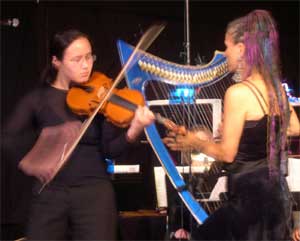 |
PHOTO TO COME LATER |
WAY
YOU ARE BLUES:
Ever since I first went to teach at the Edinburgh Harp Festival,
I’ve realized that the lever harp is an incredible blues
instrument. The levers are perfect for sliding into those moaning
“blues notes,” and because you can tune different
octaves of the harp in different keys, you can get certain dissonances
and blues-like chords with much more ease than on a pedal harp.
“Way You Are Blues” is a 12-bar blues featuring
the lever harp and voice, with a high-energy “distorted”
harp cadenza (think rock guitar to get an idea how this sounds). |
| NIGHTINGALE:
This song didn’t even seem like a song, at first. It was
so simple, and so expressive of a feeling I’d had for
so long, that it seemed as natural as sighing. I wrote it at
a time when I was still trying to prove myself as a dynamic
player, and it was such a simple, honest and revealing piece
that I was nervous about performing it. Several other performers
finally convinced me to risk singing it, and instantly audiences
began to ask for it again and again. Orchestrating it was also
a challenge for me. Most of my orchestrations before had all
been bombastic and rhythmic. This piece was so tender I simply
wasn’t sure how to approach it. so I just approached it
as delicately and simply as I could, with a reduced orchestra
(strings and woodwinds). Particularly when I’m performing
the orchestral version, this piece has a magic for me, an ability
to transport me to a series of moments in my life. The one thing
each of these moments share is that my mother is singing. I
must have subconsciously tried to portray that in the orchestration
because one day a few years ago when I was performing with the
Syracuse Symphony, and when the English Horn was playing so
soulfully and tenderly, I felt suddenly that her spirit was
completely alive in the piece, and coming through his instrument. |
PHOTO TO COME LATER |
PHOTO TO COME LATER |
BELINDA
[story
to come later] |
| CATCHER
IN THE RYE:
In about 1990, I was playing with some friends in Scotland,
when I was struck by the paradox of the achingly beautiful Scottish
ballads and the driving rhythms of the contemporary Scottish
bands. I was also thinking about how these ballads had infused
our American culture, and how the simple ballad “Comin’
Through the Rye” had been the moving theme of the great
Amercian coming-of-age novel, “Catcher in the Rye.”
I knew that both the longing of the ballad and the ..... of
the novel are part of me, part of my emotional and cultural
vocabulary. I wanted — I could say I needed — to
put them together in one piece of music. This piece connects
the original ballad with a single, pivotal paragraph of the
novel. Instrumentally, it features the electric lever harp and
timpani or frame drums, strings and brass, with a haunting solo
for English Horn |
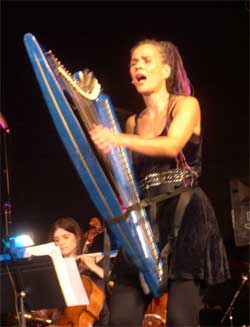 |
|
| The
second half of the show features the pedal harp. |
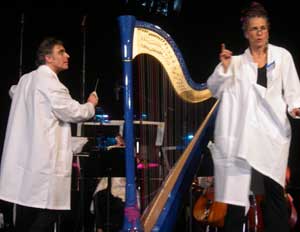 |
DANGER
ZONE:
In the mid-90’s the editor of the “Journal of Improbable
Results” gave me an article entitle “Stress Analysis
of a Strapless Evening Gown” and suggested that I write
a suite based on it. I did write that suite, and “Danger
Zone” was one of the movements. It’s a quirky, bombastic
piece for harp and orchestra. It has very colorful orchestrations,
a big Trombone solo and an “experimental” harp cadenza
that explores some of the lesser known effects available on
the harp. To get the full effect, I’ve asked the entire
orchestra to play dressed in lab coats. Will they do it? You
can find out! |
MERCEDITAS:
I met Mexican harpist Mercedes Gomez in the mid-90's. The
freedom of Mercedes’ imagination matches my own and
our friendship bubbled like hotsprings, our emails mixing
the impossible and the everyday in a special magic of words
and images. We wanted to spend more time together, to play
music and to experiment mixing music and dance, so I decided
to write a piece we could play together. In fact, I wrote
a whole concerto for two harps, which was commissioned by
the CAMAC harp company -- and Mercedes and I premiered it
at the World Harp Congress in Prague that year. The second
movement, a lush waltz, was the most romantic piece I had
ever written -- because both Mercedes and I were falling in
love — me with my partner Jonathan, and she with her
current husband, Bosse. We both had much to overcome in these
relationships and when I wrote this movement I poured our
longing and love into the notes, and could feel us, each in
different worlds, dancing to the same music with the men we
would spend the rest of our lives with. I don’t think
I have ever written any piece that was more unabashedly romantic.
Originally for two harps and orchestra, I rewrote it in 2005
for solo harp and orchestra, and premiere that version on
the DVD with the Grand Rapids Symphony in 2005. |
PHOTO TO COME LATER |
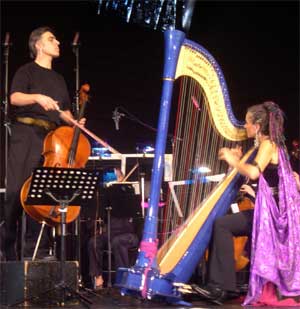 |
996:
My work has always been half-story, half-music. So it’s
no accident that the story of Sheherezade, the woman who saved
her own life by telling stories, had a special attraction for
me. In the early 90's, I wrote a solo piece about Sheherezade
and called it “996” in reference to the 1001 Arabian
nights -- the 1001 stories Sheherezade told to save her life.
In 2005, when we received the go-ahead for the symphonic DVD,
I asked conductor David Lockington if he had any requests for
the project. He said that his only request was that I write
a piece for him and me to play together. For me this was a thrilling
request. David is a dramatic and willing performer, and as I
searched for the right piece for us, I realized I wanted to
arrange the story — I mean the music — of 996 as
a sort of concerto for harp and cello. By doing that I hoped
to bring out the drama and emotion not just of Sheherezade herself,
but the of her relationship with the Sultan who would have killed
her but for the stories she told.
What I couldn’t have expected was that David’s involvement
would reveal an even more compelling part of the story: the
redemption of the Sultan through the power of storytelling.
Why is it the piece called 996? Ah ... all this will be explained
in the performance and the DVD!
Technically, this piece is fascinating to play, as it utilizes
the full range of the harp and techniques like pedal slides
and string bends to create both atmosphere and Middle Eastern
melodies.
And "How is it," you may ask, "that the conductor
can step down off the podium, play cello with the soloist and
still lead the orchestra?" Aha! One of the great benefits
of working with the Grand Rapids Symphony is their wonderful
associate conductor, John Varineau, who agreed to guest conduct
on this program. John will take over the podium for this piece. |
| HEALING
THE WATERS:
Healing the Waters is a passacaglia for harp, cello and clarinet,
which will be played by me on harp, David Lockington on Cello
and John Varineau, the GRS Associate Conductor, on Clarinet.
“Healing the Waters” is a love song for the man
who made this collaborative project possible, Peter Wege. Peter
is a passionate environmentalist and supporter of the arts.
Peter and I became friends after my first performance in Grand
Rapids. We are both passionate about water, and one of Peter’s
projects is the healing of Lake Michigan, a project he calls
“Healing the Waters” and one he’s poured his
heart and his soul into. "Healing the Waters" is choreographed
for two dancers by Grand Rapids Ballet artistic director Gordon
Peirce Schmidt, who I've long hoped to collaborate with. The
collaboration is an offering of love and appreciation for a
man who has personally affected the lives of everyone on stage
and whose spirit and dreams have enriched my own life in a thousand
ways. (The dancer in this photo is my friend Karen Montanaro,
who came to help us workshop the piece in September '05) |
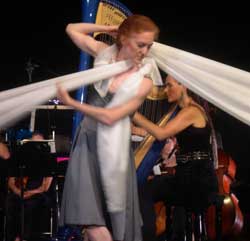 |
PHOTO TO COME LATER |
CONGRATULATIONS,
YOU MADE IT THIS FAR: Turning
40 was a trauma for me. In part because I never thought I’d
live that long — and in part because the longer I live,
the more I realize it’s impossible to live up to the image
of success I had when I was a kid. I wrote this song just to
help me make it through that birthday. And I’ve been singing
it every since. Apparently a lot of other people sing it, too,
judging by the number of emails I get about it. Hearing the
audience singing back at me during this song is always very
emotional. Performing it with symphony orchestra just puts that
emotion over the top for me. And here’s the kicker: we’re
recording this DVD Nov. 11, 12 & 13. And my birthday is
... Nov. 11. How I’ll get through this song on stage that
weekend I don’t know. |
BAROQUE
FLAMENCO:
I started the harp seriously when I was 22. A few months after
I started playing, I landed a job playing background music in
a ritzy hotel. I got the job based on the fact that I had the
wardrobe (a long gown), not on my playing ability. Basically,
I could play four tunes, most of them out of a beginner’s
book called “Medieval to Modern.” My saving grace
was that I could improvise, so I was able to make each piece
last anywhere from 15 – 20 minutes. My favorite harp tune
was a little minuet by Jean Jacque Rousseau. I loved it because
of the melody and because it had two contrasting sections. One
was melodic and recognizable, the other was structured in a
way to make it easy and satisfying to improvise over. So I would
play the melody, then improvise on the contrasting “B”
section until I got hopelessly lost. Just as the dining patrons
were beginning to wonder if I knew what I was doing (as you
may be wondering vis-a-vis this description.) I would go back
to the melody, and once I had my bearings and they'd stopped
looking at me askance, I'd start improvising again.
So the piece was not just music, but a musical game, and a safe
place to experiment. Little by little, as I got more comfortable
playing it, the two sections began to contrast each other more,
and as the years went on, the piece became more and more varied.
One day I realized the two sections had completely diverged:
one sounded completely Baroque and the other was markedly Flamencish.
I followed the lead of the tune and after more expreimentation,
I discovered a whole new world in the music: a story of Flamenco
dancers and a time machine that took them to Marie Antoinette’s
boudoire. From there the piece developed to fulfill the story,
as the Flamenco dancers ultimately take over the French court.
The piece became my signature piece, with a dramatic, percussive
Flamenco Cadenza. When the Boston Pops called me in 1995 and
asked me to perform as a featured soloist with them, I knew
I wanted to arrange this piece for full orchestra. I've probably
played this piece more times than any other in my repertoire
-- and it's still just as challenging and just as much fun.
|
PHOTO TO COME LATER |
SNEAKY
SNEAKY: HERE ARE THE ENCORES
Ha! Of course we prepare encores! We only hope the audience
will beg for them — and that we’ll have time left
on the program to perform them! Unlike solo performers and
bands, huge orchestras can’t keep playing encores ad
infinitum or they’ll be fined “overtime”
fees. So IF there’s time, here’s what we’re
preparing for encores. Pssst! Don’t tell the audience!
It’s supposed to be a surprise.
|
PHOTO TO COME LATER |
GARBAGEMAN:
Around Thanksgiving 2004, I decided I wanted to write a Song
of Thanks. I said to myself, “But Deborah, tell me honestly
now, what are you TRULY thankful for?” Immediately one
image came to my mind: my garbageman. Ever since learning of
the theory of relativity, and realizing that garbage —
unless it’s biodegradable -- never really disappears,
I’ve had nightmares that someday I will be confronted
by every piece of plastic and styrofoam I’ve ever thrown
away. Seeing the garbage collectors each week is a profound
relief. I’m not joking! I have to admit, I also like the
noise of the trucks, the cans and the yelling (which sounded
a lot to me like my mother’s opera singing, when I was
a kid). I premiered this ode to the garbage collector in 2004
and it became an immediate audience hit, especially the garbagecan
cadenza. |
| NEW
BLUES:
This was one of the first “blues” I wrote for the
harp, before I understood the 12-bar blues form, and the idea
that the Blues is usually a slow “bluesy” type of
tune. This is really more of a bebop tune, with a melody that’s
a combination 12-bar blues and 16-bar blues (don’t ask
how I did that. It's the kind of thing you can only do when
you don't know what you're doing.) I premiered the orchestral
version of this piece with the Grand Rapids Symphony in 2001.
Their harpist, Elizabeth Wooster, had been playing with them
less than one season, so when she came out to the front of the
orchestra, tore off her black orchestra gown and played this
piece with me in mini-skirt and fishnet stockings, the crowd
went wild -- and everyone in the orchestra's eyes nearly popped
out. Will she do it again on the DVD? Wouldn’t you like
to know!! |
PHOTO TO COME LATER |
|




